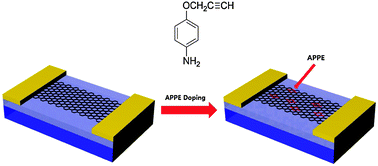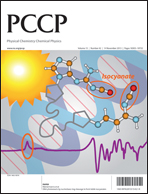Efficient n-doping of graphene films by APPE (aminophenyl propargyl ether): a substituent effect
Abstract
We report the synthesis and applications of APPE (aminophenyl propargyl ether) as a novel n-type dopant for graphene. The characteristics of APPE-doped graphene films were investigated using Raman spectroscopy as well as electron transport measurements. The Raman 2D/G peak ratio decreased by more than 40%, and the minimum conductivity voltage (Dirac voltage) was shifted to −133 V as the pristine graphene was doped with APPE, indicating that the graphene was strongly n-doped. We suppose that the electron donating property of the amine group (–NH2) is the origin of such an intense n-doping effect. In contrast, a similar molecule with an electron withdrawing nitro group (–NO2) (nitrophenyl propargyl ether, NPPE) showed a slight p-doping effect. Thus, we conclude that the doping effect of a molecular framework strongly depends on the functional substituents, which can be represented by the Hammett equation. We also confirmed that the sheet resistance of the APPE doped graphene film was reduced by ∼70%, which is crucial to enhance the electrical conductivity of graphene for various electronic applications. In addition, the acetylene group of APPE appears promising to be utilized in “click chemistry” to further functionalize the π-surface of graphene for sensors and bio applications.


 Please wait while we load your content...
Please wait while we load your content...